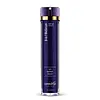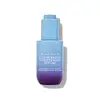What's inside
What's inside
 Key Ingredients
Key Ingredients

 Benefits
Benefits

 Concerns
Concerns

No concerns
 Ingredients Side-by-side
Ingredients Side-by-side

Water
Skin ConditioningCyclopentasiloxane
EmollientGlycerin
HumectantNiacinamide
SmoothingSinorhizobium Meliloti Ferment Filtrate
Skin ConditioningOctyldodecanol
EmollientDimethicone
EmollientPolysorbate 20
EmulsifyingDimethicone/Vinyl Dimethicone Crosspolymer
Skin ConditioningLauryl PEG-9 Polydimethylsiloxyethyl Dimethicone
Skin ConditioningAmmonium Acryloyldimethyltaurate/Vp Copolymer
Phospholipids
Skin ConditioningSh-Oligopeptide-5 Sp
BleachingSh-Oligopeptide-102 Sp
Skin ConditioningPalmitoyl Tripeptide-38
Skin ConditioningSodium Hyaluronate
HumectantArabidopsis Thaliana Extract
AntioxidantRibes Nigrum Seed Oil
EmollientHelianthus Annuus Seed Oil Unsaponifiables
EmollientCardiospermum Halicacabum Flower/Leaf/Vine Extract
Skin ConditioningErgothioneine
AntioxidantRosmarinus Officinalis Leaf Extract
AntimicrobialHelianthus Annuus Seed Oil
EmollientTocopheryl Acetate
AntioxidantUbiquinone
AntioxidantLeuconostoc/Radish Root Ferment Filtrate
AntimicrobialTocopherol
AntioxidantEpigallocatechin Gallatyl Glucoside
AntioxidantSerum Albumin
HumectantAlanyl Glutamine
HumectantCetyl Hydroxyethylcellulose
Emulsion StabilisingLecithin
EmollientHydroxypropyl Cyclodextrin
MaskingPhytic Acid
Phenoxyethanol
PreservativeCaprylyl Glycol
EmollientEthylhexylglycerin
Skin ConditioningHexylene Glycol
EmulsifyingSodium Chloride
MaskingWater, Cyclopentasiloxane, Glycerin, Niacinamide, Sinorhizobium Meliloti Ferment Filtrate, Octyldodecanol, Dimethicone, Polysorbate 20, Dimethicone/Vinyl Dimethicone Crosspolymer, Lauryl PEG-9 Polydimethylsiloxyethyl Dimethicone, Ammonium Acryloyldimethyltaurate/Vp Copolymer, Phospholipids, Sh-Oligopeptide-5 Sp, Sh-Oligopeptide-102 Sp, Palmitoyl Tripeptide-38, Sodium Hyaluronate, Arabidopsis Thaliana Extract, Ribes Nigrum Seed Oil, Helianthus Annuus Seed Oil Unsaponifiables, Cardiospermum Halicacabum Flower/Leaf/Vine Extract, Ergothioneine, Rosmarinus Officinalis Leaf Extract, Helianthus Annuus Seed Oil, Tocopheryl Acetate, Ubiquinone, Leuconostoc/Radish Root Ferment Filtrate, Tocopherol, Epigallocatechin Gallatyl Glucoside, Serum Albumin, Alanyl Glutamine, Cetyl Hydroxyethylcellulose, Lecithin, Hydroxypropyl Cyclodextrin, Phytic Acid, Phenoxyethanol, Caprylyl Glycol, Ethylhexylglycerin, Hexylene Glycol, Sodium Chloride
Water
Skin ConditioningGlycerin
HumectantPropanediol
SolventNiacinamide
SmoothingAcetyl Glycyl Beta-Alanine
Skin ConditioningAlpha-Arbutin
AntioxidantCentella Asiatica Leaf Extract
Skin ConditioningTetrapeptide-30
Skin ConditioningCopper Palmitoyl Heptapeptide-14
Skin ConditioningPalmitoyl Sh-Heptapeptide-12 Sp
Skin ConditioningTulipa Gesneriana Flower Extract
Skin ConditioningCrocus Chrysanthus Bulb Extract
Skin ConditioningGlycyrrhiza Glabra Root Extract
BleachingKinetin
Skin ConditioningIndole Acetic Acid
Skin ConditioningAvena Sativa Kernel Extract
AbrasiveCorallina Officinalis Extract
Skin ConditioningPanthenol
Skin ConditioningAllantoin
Skin ConditioningMelia Azadirachta Flower Extract
Skin ConditioningMelia Azadirachta Leaf Extract
Skin ConditioningCoccinia Indica Fruit Extract
Skin ConditioningCamellia Sinensis Leaf Extract
AntimicrobialSodium Hyaluronate
HumectantLactic Acid/Glycolic Acid Copolymer
Skin ConditioningBetaine
HumectantAcacia Senegal Gum
MaskingXanthan Gum
EmulsifyingPotassium Sorbate
PreservativeSodium Benzoate
MaskingMaltodextrin
AbsorbentCaprylyl Glycol
Emollient1,2-Hexanediol
Skin ConditioningPolyvinyl Alcohol
Sodium Hydroxide
BufferingCitric Acid
BufferingWater, Glycerin, Propanediol, Niacinamide, Acetyl Glycyl Beta-Alanine, Alpha-Arbutin, Centella Asiatica Leaf Extract, Tetrapeptide-30, Copper Palmitoyl Heptapeptide-14, Palmitoyl Sh-Heptapeptide-12 Sp, Tulipa Gesneriana Flower Extract, Crocus Chrysanthus Bulb Extract, Glycyrrhiza Glabra Root Extract, Kinetin, Indole Acetic Acid, Avena Sativa Kernel Extract, Corallina Officinalis Extract, Panthenol, Allantoin, Melia Azadirachta Flower Extract, Melia Azadirachta Leaf Extract, Coccinia Indica Fruit Extract, Camellia Sinensis Leaf Extract, Sodium Hyaluronate, Lactic Acid/Glycolic Acid Copolymer, Betaine, Acacia Senegal Gum, Xanthan Gum, Potassium Sorbate, Sodium Benzoate, Maltodextrin, Caprylyl Glycol, 1,2-Hexanediol, Polyvinyl Alcohol, Sodium Hydroxide, Citric Acid
Ingredients Explained
These ingredients are found in both products.
Ingredients higher up in an ingredient list are typically present in a larger amount.
Caprylyl Glycol is a humectant and emollient, meaning it attracts and preserves moisture.
It is a common ingredient in many products, especially those designed to hydrate skin. The primary benefits are retaining moisture, skin softening, and promoting a healthy skin barrier.
Though Caprylyl Glycol is an alcohol derived from fatty acids, it is not the kind that can dry out skin.
This ingredient is also used as a preservative to extend the life of products. It has slight antimicrobial properties.
Learn more about Caprylyl GlycolGlycerin is already naturally found in your skin. It helps moisturize and protect your skin.
A study from 2016 found glycerin to be more effective as a humectant than AHAs and hyaluronic acid.
As a humectant, it helps the skin stay hydrated by pulling moisture to your skin. The low molecular weight of glycerin allows it to pull moisture into the deeper layers of your skin.
Hydrated skin improves your skin barrier; Your skin barrier helps protect against irritants and bacteria.
Glycerin has also been found to have antimicrobial and antiviral properties. Due to these properties, glycerin is often used in wound and burn treatments.
In cosmetics, glycerin is usually derived from plants such as soybean or palm. However, it can also be sourced from animals, such as tallow or animal fat.
This ingredient is organic, colorless, odorless, and non-toxic.
Glycerin is the name for this ingredient in American English. British English uses Glycerol/Glycerine.
Learn more about GlycerinNiacinamide is a multitasking form of vitamin B3 that strengthens the skin barrier, reduces pores and dark spots, regulates oil, and improves signs of aging.
And the best part? It's gentle and well-tolerated by most skin types, including sensitive and reactive skin.
You might have heard of "niacin flush", or the reddening of skin that causes itchiness. Niacinamide has not been found to cause this.
In very rare cases, some individuals may not be able to tolerate niacinamide at all or experience an allergic reaction to it.
If you are experiencing flaking, irritation, and dryness with this ingredient, be sure to double check all your products as this ingredient can be found in all categories of skincare.
When incorporating niacinamide into your routine, look out for concentration amounts. Typically, 5% niacinamide provides benefits such as fading dark spots. However, if you have sensitive skin, it is better to begin with a smaller concentration.
When you apply niacinamide to your skin, your body converts it into nicotinamide adenine dinucleotide (NAD). NAD is an essential coenzyme that is already found in your cells as "fuel" and powers countless biological processes.
In your skin, NAD helps repair cell damage, produce new healthy cells, support collagen production, strengthen the skin barrier, and fight environmental stressors (like UV and pollution).
Our natural NAD levels start to decline with age, leading to slower skin repair, visible aging, and a weaker skin barrier. By providing your skin niacinamide, you're recharging your skin's NAD levels. This leads to stronger, healthier, and younger looking skin.
Another name for vitamin B3 is nicotinamide. This vitamin is water-soluble and our bodies don't store it. We obtain Vitamin B3 from either food or skincare. Meat, fish, wheat, yeast, and leafy greens contain vitamin B3.
The type of niacinamide used in skincare is synthetically created.
Learn more about NiacinamideSodium Hyaluronate is hyaluronic acid's salt form. It is commonly derived from the sodium salt of hyaluronic acid.
Like hyaluronic acid, it is great at holding water and acts as a humectant. This makes it a great skin hydrating ingredient.
Sodium Hyaluronate is naturally occurring in our bodies and is mostly found in eye fluid and joints.
These are some other common types of Hyaluronic Acid:
Learn more about Sodium HyaluronateWater. It's the most common cosmetic ingredient of all. You'll usually see it at the top of ingredient lists, meaning that it makes up the largest part of the product.
So why is it so popular? Water most often acts as a solvent - this means that it helps dissolve other ingredients into the formulation.
You'll also recognize water as that liquid we all need to stay alive. If you see this, drink a glass of water. Stay hydrated!
Learn more about Water